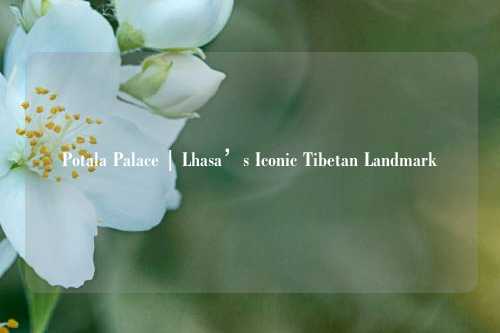Potala Palace | Lhasa’s Iconic Tibetan Landmark
The Timeless Majesty of the Potala Palace
Nestled atop Marpo Hill in the heart of Lhasa, the Potala Palace stands as a testament to the rich and spiritual heritage of Tibet. Its grandiose structure, rising like a celestial fortress against the clear blue sky, has captivated visitors and locals alike for centuries. The Potala Palace is not just a建筑; it is a living entity that breathes history, faith, and artistry.

The origins of the Potala Palace date back to the seventh century when King Songtsen Gampo, the founder of the Tibetan Empire, built the initial structure as a beacon of his love for Princess Wencheng, a Chinese princess from the Tang Dynasty. The couple's union marked the beginning of exchanges between Tibet and China, laying the foundation for the Potala Palace's role as a symbol of unity and faith. Over the centuries, the palace underwent numerous renovations and expansions, evolving into the imposing structure we know today.
The Potala Palace is a marvel of Tibetan architecture, blending Tibetan design with Chinese and Nepalese influences. Its white walls, red roofs, and richly ornamented windows create a striking contrast against the stark, snow-capped Himalayan peaks that surround it. The palace is divided into two main sections: the Red Palace, which is the spiritual heart of the complex, and the White Palace, which served as the administrative and residential quarters for the Dalai Lamas.
The Red Palace, or the "Red Fort," is the most iconic part of the Potala. It houses the Stacked Scripture Room, where thousands of Buddhist texts are stored, and the Hall of the Great Successor, the final resting place of the Fifth Dalai Lama. The walls of the Red Palace are adorned with murals that depict scenes from Tibetan history, mythology, and Buddhism. These murals are not only works of art but also historical records that offer insights into the lives and beliefs of ancient Tibetans.
The White Palace, on the other hand, reflects the administrative and residential aspects of the Potala. It was home to the successive Dalai Lamas and their entourage. The architecture of the White Palace is more , with ornate wooden carvings and Tibetan-style decorations. The palace's design is a testament to the skill and craftsmanship of the Tibetan people, who have preserved this architectural gem for generations.
Visiting the Potala Palace is not just about admiring its physical beauty but also about experiencing the spiritual energy that emanates from its walls. The palace is a sacred site for Tibetans, who believe it to be the dwelling place of the Dalai Lama and the site of numerous spiritual teachings. Non-Tibetans are also drawn to the palace, not only for its architectural splendor but also for its serene atmosphere and the sense of history it evokes.
Walking through the Potala's corridors, one can't help but feel a deep sense of awe and respect for the lives of those who once lived and worked within its walls. The palace's history is a tapestry woven with threads of faith, politics, and culture. It is a reminder of the enduring strength of Tibetan identity and the resilience of its people.
The Spiritual and Cultural Significance of the Potala Palace
The Potala Palace is more than just a historical landmark—it is a symbol of faith, culture, and resilience. For Tibetans, the palace is a divine site, a place where the earthly and the spiritual realms converge. It is a source of pride and inspiration, a beacon of hope in a rapidly changing world.
The palace's spiritual significance is deeply rooted in Tibetan Buddhism. It is believed to be the earthly manifestation of Mount Meru, the sacred mountain in Buddhist cosmology. The Dalai Lama, who is considered the reincarnation of the Bodhisattva of Compassion, has historically resided in the Potala Palace. The palace is also the site of numerous religious teachings, rituals, and gatherings, making it a focal point of Tibetan spiritual life.
The Potala Palace is also a treasure trove of art and culture. Its walls are adorned with thousands of murals that depict scenes from Buddhist stories, historical events, and the lives of saints and lamas. These murals are not only beautiful but also serve as a window into the beliefs and practices of ancient Tibet. The palace is home to thousands of statues, thangkas (religious paintings), and other sacred objects, making it a repository of Tibetan artistic and spiritual heritage.
In addition to its spiritual and importance, the Potala Palace is a symbol of resistance and endurance. Throughout history, the palace has served as a symbol of Tibetan sovereignty and identity. Even in the face of external pressures and changes, the Potala Palace has remained a steadfast reminder of Tibet's rich history and traditions.
Today, the Potala Palace stands as a UNESCO World Heritage Site, recognized for its outstanding universal value. It is a destination for pilgrims, tourists, and scholars alike, who come to pay homage to its beauty, history, and spiritual significance. The palace is also a reminder of the importance of preserving heritage in an increasingly globalized world.
For those who visit the Potala Palace, the experience is deeply transformative. The palace's grandeur, history, and spiritual energy leave an indelible mark on the hearts of all who enter its gates. It is a place where the past and present converge, where the spiritual and the earthly intermingle, and where the beauty of Tibet's heritage is fully realized.
, the Potala Palace is more than just a building; it is a living testament to the resilience, faith, and richness of Tibet. It is a place where the spiritual and the historical converge, where the past and present coexist in perfect harmony. For anyone who has the opportunity to visit the Potala Palace, it is an experience that will stay with them forever—a reminder of the beauty, complexity, and enduring spirit of Tibet.
















